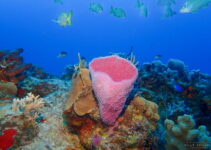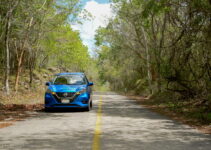If you look at its surface, you would never guess what a wondrous and unique dive site Cenote Angelita hides. But then you start to descend and suddenly see tree branches that emerge from a thick white cloud and look like they are trying to reach the surface they once called their habitat.
It feels like you are looking at the bottom of the cenote, and then a diver emerges out of the white cloud. The white mass is stirred up and suddenly looks like a slowly moving river. And the longer you look at it, the more it feels like you are suddenly floating above the surface of an underwater river.
It is a stunning view, and while said cloud is actually a thick hydrogen sulfide that sits upon the halocline and not an actual river, seeing it is an experience, unlike any other cenote dive. The Cenote Angelita dive makes you feel like you are actually flying as it is easy to imagine that the debris mount and branches or an island around which a white cloudy river flows.

I had the chance to dive in this marvelous cenote during my first Mexico trip, and a minor dive computer issue aside, love the dive. While I thought I knew what it was like to dive Cenote Angelita, the actual experience far exceeded my expectation. I can only encourage every qualified diver to experience this unique cenote themselves. Here is what you need to know about the cenote and diving in it:
What is a cenote?
A cenote (pronounced ‘seh-‘no-tay‘) is a water-filled sinkhole or natural well. There are formed when water dissolves the limestone bedrock, which creates an underground chamber, whose roof collapses.
The term ‘cenote’ derives from the Mayan word ‘dzonot‘ (‘ts’onot‘), and means ‘cave filled with water.’ Therefore, the word is only used to describe Mexico’s sinkholes. More than 6.000 of them can be found in the Yucatan Peninsula.
To this day the Maya consider the cenotes to be entrances to the underworld, Xibalba, and a place to connect with the gods. Therefore, cenotes are sacred and ceremonial places.
The classification of cenotes is connected to the age of the cenote. The classifications of as follows:
- Open Cenotes: These are the oldest cenotes. Their roof has fully collapsed which makes them look like small lakes. Cenote Angelita is one of the open cenotes near Tulum.
- Semi-Open Cenotes: Semi-open cenotes have a larger opening. However, their diameter is wider than the opening itself, which makes them bottle-shaped.
- Closed / Cave Cenotes: These cenotes have an intact ceiling and tend to have the most impressive stalagmites and stalactites. Usually, there are small holes in the ceiling through which light enters the cave. This light often creates a stunning light beam effect. Cenote Suytun, one of the cenotes near Valladolid, is a closed cenote.
About Cenote Angelita
Cenote Angelita is a circular open cenote with a diameter of 25 meters and is surrounded by lush green trees. Its name translates to ‘little angel’ and originates from a stalactite inside the cenotes that is known as Angel Stalactite.
It has a water temperature of 25 °C (78 °F), and a halocline at a depth of 30 meters (98 ft). Like in the other cenotes, there is fresh water above the halocline, and salt water below it. However, this cenote also has a thick white cloud that consists of hydrogen sulfide and that rests upon the halocline.
While the hydrogen sulfide cloud and the trees of the debris mount create a riverfront-like scene, there is no actual underwater river in Cenote Angelita.
There are very few fish in Cenote Angelita, but you might spot a small crocodile at the surface.
Unlike most other cenotes near Tulum, Cenote Angelita has no connection to other cenotes. It is located between the two largest underwater cave systems in the world.

How deep is Cenote Angelita?
Cenote Angelita has a depth of around 60 meters. On one side of the debris mount, it goes down to just above 40 meters and down to around 60 meters on the other side. Going to this depth is only suitable for technical divers.
Why is there hydrogen sulfide in Cenote Angelita?
The hydrogen sulfide in Cenote Angelita is the result of the bacterial breakdown of organic matter where there is no oxygen. There is a steady supply of new organic matter thanks to the trees that surround the cenote.
Things to know about Cenote Angelita
Entrance Fee
When I visited Cenote Angelita, the entrance fee was 300 MXN (∼15 USD) for divers and 100 MXN (∼5 USD) for swimmers. If you are a diver, the entrance fee might be included in the diving price of your dive center. Ask the dive center or independent instructor ahead of the diving day, so you know if you have to bring cash.
Camera Fees
The camera fee at Cenote Angelita is 500 MXN per camera, which is approximately 25 USD. This fee makes it one of the cenotes with the highest camera fees. Bring a sufficient amount of cash.

Given how deep and dark it is, I recommend only bringing your camera, and therefore paying that fee, if you have a proper camera setup with flashes or good video lights. Without those, you will likely only be wasting your money. Just enjoy this unique dive without focusing on photography.
Alternatively, you can also ask the dive center of your choice if they have a photographer you can hire to take photos of you during the dive.
Opening Hours
Cenote Angelita is open daily from 8 AM to 5 PM. The best time to dive Cenote Angelita is early in the morning just after 8 AM as the hydrogen sulfide cloud has not yet been disturbed by other divers. It is a great dive site year-round.
Facilities
These days, there are bathrooms on-site. In addition to that, there are a few tables where you can assemble your dive gear.
There is also a palapa with a hammock and some chairs right at the cenote. It is the ideal place to wait if divers or swimmers are accompanied by someone that does not want to enter the water.
While parts of the walk from the parking spots and tables to the cenote are on somewhat uneven terrain, the last few meters are a wooden walkway. There is also a short staircase leading down into the cenote, so getting in and out is no hardship. However, you should be careful when walking up and down the wooden steps, as they can be slippery.



Cenote Angelita Dive
The Cenote Angelita dive will make you fall in love with diving in cenotes. And while all cenotes are incredible, this cenote is unique. Be sure to add this bucket list dive to your list of places to dive in Mexico.
While diving always feels like flying, the feeling is further intensified in this cenote. When undisturbed, the hydrogen sulfide cloud of Cenote Angelita looks like an underwater river above which divers are floating. It is an experience unlike any other. Getting to dive in this cenote is one of the best reasons to become a diver.

The Cenote Angelita dive is a deep dive, so it is only suitable for experienced divers that have a depth certification and that feel comfortable in the limited visibility of the hydrogen sulfide cloud and below it.
As I am not a tech diver, my dive went to a depth of 33 meters and lasted 34 minutes. This means my dive profile was similar to that of most depth-certified divers. After all, most dive centers take you to a maximum depth of 30 to 40 meters (98 to 131 ft). If you are not a certified cave diver, you have to be accompanied by a certified guide.
After an approximately 5-minute long walk from the parking spots to the cenote, you start your Cenote Angelita dive by descending down to the top of the debris mount at around 25 meters (82 ft).
Hereby, the visibility can be quite bad in the first few meters. When I dived in Angelita in May, even the first few meters had good visibility, but be prepared that it might not be the case.
Once at the debris mount, it suddenly feels like you are diving on another planet. Thick tree branches arch into the water and out of a white milky layer, and here and there, fallen leaves can be seen on the mount.
It is an eerie appearance, but also incredibly fascinating. Most divers, and especially photographers usually spent some time taking in and capturing this spooky environment.

Ensure that your torch is turned on, and then you slowly descend into the white cloud. This hydrogen sulfide cloud is more than 3 meters (9.8 ft) thick and is located at a depth between 27 meters and 30 meters (98 ft).
The visibility inside the thick hydrogen sulfide layer is very limited, which can cause some divers to panic. Especially, as it is at a depth where nitrogen narcosis can set in. So stay close to your dive buddy and observe his or her reactions.
It is a thrilling and nerve-wracking experience even if you are an experienced diver, it is likely the first time you are diving into a dense toxic cloud. Hydrogen sulfide is toxic, but it is safe to dive through the cloud as you are breathing compressed air. However, you might still notice the smell of rotten eggs.



The Cenote Angelita dive turns into a night dive below the hydrogen sulfide layer, but if you are not a technical diver, you will not spend a lot of time below the cloud. After only a short while, you and your guide will slowly start to ascend.

There is a small swim-through near the Angel Stalagmite. The tunnel has a length of around 10 to 13 meters, and most divers swim through it near the end of their dive, to extend the duration of the dive.
There are a few bigger stalactites at the edges of the cenotes at this depth. Take a look at them and try to figure out why one of them is called the ‘Angel Stalactite’. I, for one, could not find the angle from which it resembles an angel.


If the first few meters of Cenote Angelita had good visibility, it is worth it to look up during your safety stop. You should be able to see the silhouette of the trees that surround the surface, and on a sunny day, there might even be some light rays that penetrate the water.
And while this is the end of your dive, the experience itself will be on your mind for a long time to come. It certainly is a unique dive, and even now, months after the dive itself, I can still vividly recall what it was like to float above Cenote Angelita’s hydrogen sulfide cloud before descending into it.
Which dive center to choose?
A dive in Cenote Angelita is offered by most dive centers in Tulum and Playa del Carmen, but as always some dive centers are better than others. Visit the dive center of your choice and have a chat with them before booking your dive.
Based on my own experience, I highly recommend Ko’ox Diving. ‘Ko’ox’ is Mayan for ‘let’s go’ and perfectly covers the spirit of this dive center. This amazing locally-owned dive center employs excellent dive guides, and I loved diving with them.

Other Things to Do at Cenote Angelita
Freediving
In addition to scuba diving, it is also possible to freedive in Cenote Angelita. To make the most of freediving in this cenote, you have to be certified to dive to a depth of 30 meters (98 feet), so you can observe the tree branches arching out of the white cloud.
Swimming & Snorkeling
It is allowed to swim and snorkel in this cenote. However, it is not the most exciting cenote for doing so. After all, the real appeal of this stunning cenote is deep below the surface and can only be enjoyed by advanced scuba divers and freedivers. Additionally, there are a lot of mosquitos, which would make swimming in this cenote less pleasant.
Can you swim in Cenote Angelita?
You can swim in Cenote Angelita, but there are much better cenotes for swimming.
How to get there
Dive centers will usually drive you to the cenote, but it is also possible to drive there by yourself. It is located south of Tulum, 16 km down Highway 307 (Chetumal – Cancun), and there is a sign that can be seen as you drive down the highway. You can park on the property not too far away from Cenote Angelita.
Cenote Angelita Rules
Like nearly all other cenotes, there are rules you have to follow if you want to enter Cenote Angelita.
- Applying sunscreen before you enter the cenote is not allowed, as even eco-friendly sunscreen could endanger the ecosystem of the cenote.
- It is not allowed to use mosquito spray even if there are a lot of mosquitos at Cenote Angelita.
- Do not leave your trash in or near the cenote.
- If you want to dive Cenote Angelita, you have to be accompanied by a certified guide.

This post may contain affiliate links(*), which means I may receive a commission, at no extra cost to you if you make a purchase through a link. Please see the full disclosure for further information.
What to bring
If you are diving in Cenote Angelita, you need your usual diving equipment consisting of a mask, fins, boots, BCD, regulator set, and a dive computer. Given the water temperature, a 5mm or 7 mm wetsuit is recommended. You might also need a Din-to-Yoke adapter. Additionally, you should not forget to bring a diving torch as you will definitely need it.
Should you want to go for a swim, all you have to bring is swimwear, flip flops, and a towel.
If you drop something while swimming or diving in Cenote Angelita, you will very likely never find it again. Be sure to attach everything properly.
Where to Stay
Most divers either stay in Tulum or further north in Playa del Carmen.
While cenote dives departing Playa del Carmen are slightly less expensive, the drive from there to Cenote Angelita is 79 km (49 miles) long. The Fives Downtown Hotel is a great place to stay in Playa.
Meanwhile, Downtown Tulum is only 16 km (10 miles) away from the cenote. The small cabins of Luhme are close to many of the dive centers in Tulum and ideal for a short stay of two to three days.
Should you prefer staying near the beach in Tulum’s hotel zone, you will love the Dos Ceibas Eco Retreat. Just keep in mind, that you will likely have to take a taxi to the dive center in Downtown Tulum. There are also great luxury hotels in Tulum.
Not sure how to get to Tulum? Find out how to get to Tulum from Cancun Airport.
Nearby Locations
Other Cenote Dives — If you want to do another dive after this one, Cenote Car Wash with its water lilies and cavern line is ideal. It takes 26 minutes to drive there.
Laguna Kaan Luum — Should you prefer to relax after visiting this cenote, Laguna Kaan Luum is perfect. With its turquoise water, water hammocks, and swings, it is the ideal place for a quiet afternoon on a sunny day.
Tulum Ruins — If you have not done so already, you can end your day with a visit to the ruins of Tulum. Partially situated on the cliffs, these Mayan ruins are unique and well worth a visit. Outside of the turtle season, you can also walk down the staircase to the picturesque beaches at the foot of the cliffs. Therefore, it is an ideal combination of a history lesson with some time for relaxation.
Planning a trip?
Check out these useful websites and resources I use to plan my own adventures.

Photo credits: Thanks to my dive buddy and friend Florine from World Adventure Divers and to Andres of Ko’ox Diving for providing images of me diving in Cenote Angelita for this post.
Roundup: Cenote Angelita Dive
As you can see, Cenote Angelita is rather unique, and diving in it is an experience unlike any other. Hopefully, this guide and the description of the Cenote Angelita dive were able to answer all of your questions about it.
If you are not sure if this cenote is the right cenote dive for you, I highly recommend having a chat about it with the dive center of your choice. As I said above, it is a deep dive, and diving into the cloud itself is quite different from other limited visibility dives, so please do not dive here if you do not feel ready. It is always better to skip a dive site even if it is great than to risk take great risks that could easily endanger you and your dive buddy.
With that word of caution being said: happy bubbles if you end up diving in Cenote Angelita! It is a great dive, so have fun diving in this eerie atmosphere.
More about the Yucatan
If you are planning a trip to Tulum, you might also be interested in these Mexico guides:
Mexican Pueblos Magicos
Hidden Gems in Mexico
Is cenote Angelita among your favorite cenotes?
Let me know in the comments down below!
Planning to Dive in cenote Angelita?
Pin This Cenote Guide!








I can’t even dive yet but I’ve always wanted to swim or dive in a cenote – one day! I also heard that they were very sacred in Mayan culture and connected to some mythology. This post was absolutely packed with info and I loved it. It seems this was an incredible experience!